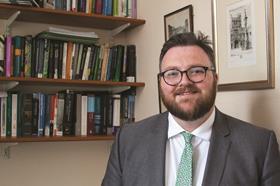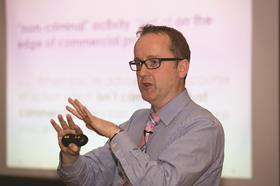Working under the auspices of University College London’s Centre for Ethics and Law, we conducted an interview-based study of legal risk. We interviewed 34 senior in-house lawyers and senior compliance staff in large corporate firms and similarly complex organisations.

In the broadest terms, legal risk management combines professional judgement with sound procedures and, for some, a more genuine grappling with changing the behaviour in their organisations and evaluating the impact of risk programmes. There are a lot of interesting differences in the sector’s approach to legal risk: its definition and management vary significantly. It is fair to say – we think – that while legal risk management is something of a voguish term in legal practice, it is also a discipline in its infancy.
In this article we concentrate on one question: how should in-house lawyers balance their ethical obligations with their obligations to the company? Risk management provides a new perspective on ethical questions about the role of in-house lawyers. Risk assessment requires professional objectivity for such assessment to be useful, yet the culture of ‘being commercial’ and a professional culture that emphasises putting the client first strains that objectivity. The professional obligation of independence is also sometimes called into question. These tensions play out in debates about whether in-house lawyers can be a moral compass for their organisations, or whether general counsel should ‘have the back’ of the CEO or the board. Balancing this tension inappropriately may sometimes exacerbate rather than ameliorate legal risk.
Objectivity, independence and professional ethics
As well as professional obligations to protect their independence and promote the best interest of the client, there are obligations on in-house solicitors to uphold the rule of law and the proper administration of justice. A solicitor’s professional obligations give primacy to the public interest, and the public interest in the administration of justice in cases of conflict. This raises the interesting question of how legal risk management – which tolerates, normalises and sometimes promotes the desirability of taking risks with law – fits with these broader professional obligations.

Issues of objectivity and independence are most clearly raised in the context of in-house lawyers being very sensitive to their place in the corporate network of influence. That sensitivity sometimes involves a negotiation between the lawyer’s view of what is lawful and right, and their view of what is tolerable. Corporate codes and pleas to take a long-term sustainable view rather than a short-term, narrowly commercial view were stronger drivers in that negotiation than professional principles.
Indeed, we found that where professional principles were called upon at all it was most usually the obligation of independence that was summoned by our interviewees. The obligation to promote the rule of law and protect the public interest in the administration of justice had limited, if any, purchase. It was not a concept that was well articulated in their professional consciousness.
Similarly, when asked more specifically whether the management and assessment of legal risk raised professional ethics issues, our interviewees broke down into three groups of broadly similar size:
- those who considered that the management of legal risk did not raise ethical issues;
- those who considered that the management of legal risk might raise ethical issues in theory, but because they had ethical employers such conflicts did not arise in practice; and
- those who considered that professional ethical problems could and did arise (occasionally there were suggestions that such problems were fairly frequent).
Those interviewees who tended to say that there were not ethical problems tended to portray advice in binary terms: either something was lawful or it was not. In this way, advice clarified and made plain the law, and clients then decided to act or not to act. This is a position at odds with the view of legal risk which sees law as somewhat uncertain. Alternatively, these interviewees indicated that where law was ambiguous, ethical decisions were purely for the business and not for them as lawyers.
You can see the risks of a lack of clarity about red lines and professional obligations if you think about recent corporate scandals.
The closest articulation of professional rule of law obligations came when interviewees talked about the concept of ‘comfort’. Interviewees contextualised getting ‘comfortable’ with law’s ambiguity but not allowing that ambiguity to be abused within the broader role of the lawyer as business adviser. Each piece of advice was part of a broader series of interactions where the lawyers worked to persuade their colleagues of their utility, relevance and commitment to the business. This meant that compromises needed to be made from time to time as part of the cost of having the legal department influence the company. Thus, one of the terrors of in-house lawyers was being perceived as ‘difficult’ and colleagues not then coming to them for advice when they ought to do so.
Professional claims to independence by our interviewees were subtle therefore. Independence did not either exist or not exist – it manifested along a continuum and could be weaker or stronger, in the same person, at different times and in different contexts. Our interviewees understood that professional independence was (sometimes) in tension with their need to serve, and be seen to serve, the business. Conversely, professional independence could be reinforced by the business (e.g. sometimes respondents reported a deliberate attempt to align the professional claim to independence with a leadership desire to do, and be seen to do, the right thing within their businesses).
Independence could be weakened, particularly where the corporate network was sceptical of the value of the legal team. More generally, a corporate discipline was at work that protected the discretion of senior decision-makers and disciplined lawyers towards corporate norms. That discipline reminded lawyers that they were there to support the business; that they advise and do not decide.
The discipline was also sometimes disciplinary. Some saw or had experienced CEOs publicly or more subtly ‘calling out’ lawyers for being obstructive. Promotion and getting allocated interesting work incentivised behaviour.
Red lines: boundaries of tolerable risk
For these reasons, in-house lawyers and the businesses they work within are allergic to the word ‘no’ being exercised by anyone other than the ultimate decision-maker. We do not mean to suggest that for in-house lawyers saying ‘no’ was impossible, or that advising in robust terms never occurred, but saying ‘no’ was seen as a last resort – and many saw it as a mark of their skill that they avoided situations where the need to do so arose. Saying ‘no’ was also a process which required political coalition-building within the business if it was to succeed. ‘No’ could be hard and dangerous work.
Discomfort and concerns about independence effectively meant that, on occasion, our in-house lawyers felt that their companies were taking unreasonable positions on legal risk or, perhaps, untenable positions on the legality of their action. We sought to explore the outer limits of the comfort/discomfort boundary: what were our interviewees’ ‘red lines’? How did they define the ethical boundaries which they would not cross?
We noted the following:
- The ability of our interviewees to articulate specific ‘red lines’ was limited.
- There was often no apparent reliance on general ethical principles from their business code of conduct, nor was there reliance on external professional principles (e.g. in the SRA Handbook).
- There was a tendency to look to the business to provide ethical leadership (in the same way as they looked to the business for a sense of risk appetite). This is not suggestive of independence or objective judgement.
- Those who indicated no red lines tended to a view that the business, not the lawyer, took all ethical decisions. Their work was technical and without an ethical dimension. We would suggest that this view is misguided and, at the very least, suggests a failure to properly engage with the professional obligations to which all regulated lawyers, including those in-house, are subject.
While professional principles were generally not called upon, professional status was perceived as useful. It helped establish a level of independence within the businesses and a basis for making claims on that independence and on the public interest. It was also said to form the basis of a claim for higher objectivity.
In broad terms, the boundaries of tolerable risk in our cohort were generally formed by an amalgam of how ambiguous a legal question was; whether it was a criminal matter; whether increased risk to person or life could be attributable to the company’s actions; reputational risks (often reflecting criminality, environmental damage and risk of injury or to life); and the costs and benefits of proceeding in the face of legal ambiguity (such as the risk of sanctions or enforcement). Some articulated a firmer notion of legality and resistance to creative compliance, while acknowledging that legality was stretched or breached in practice.
Lawyers and businesses like to project a belief in legality or working within the law. In reality, on occasion, this could mean not risking serious criminal sanction and having a defensible, if sometimes weak (or risky) argument that behaviour was otherwise within the law.
Sometimes such arguments are a response to conflicts between mutually incompatible international standards or the understandable feeling that total compliance with complex and changing law cannot be achieved. Sometimes the arguments may be a cover for creative or selective compliance, or the obfuscation of non-compliance. The elision of legality with criminal law was common, although in practice the distinction between criminal and other sanctions is not always clear.
Rethinking ethical practice

You can see the risks of a lack of clarity about ‘red lines’ and professional obligations if you think about well-known corporate scandals. In-house lawyers had a role in serious wrongdoing by BNP Paribas. The News of the World’s legal chief faced professional misconduct charges for ordering surveillance of lawyers involved in litigation against the paper (a tribunal rejected all charges). A former Barclays GC was interviewed under caution in relation to a ‘whistleblowing’ case which is ongoing (Barclays denies wrongdoing). In-house lawyers at General Motors have been in the spotlight for the way they dealt with fatal accident claims, and some banks faced scrutiny for the practice of sending letters from fake law firms. It is not, we think, a case of saying in-house lawyers are ethically suspect; in any event, we could point to similar problems in private practice.
The important point is that ethical scandals usually flow from bad decisions, not bad apples. The profession may need to take some time to rethink how it conceives of its role, how it trains individuals and teams, and how it manages ethicality within in-house practice. Better decisions are in everyone’s interests.
- This is the latest in a series of thought leadership articles on the in-house lawyer sector. It is an edited version of a chapter in The Future of the In-House Lawyer: The General Counsel Revolution, published by The Law Society (£79).
- The Law Society’s In-house Division is the community for in-house lawyers working in the corporate and public sectors, not-for-profit organisations and charities. It aims to bring in-house lawyers together to share best practice, and address current issues and challenges in a supportive environment. For more information, see the Law Society In-house division.




























No comments yet